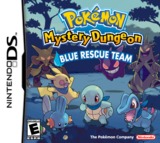Pokemon made more addictive than ever.
It saddens me as a fan of roguelikes that they did not include weaponry or armor in this game (although there are ribbons which prevent status effects or raise stats which you can give your Pokemon), but there is still an array of items to find, from the standard (seeds and fruits that let you heal, rez, or cure status effects, TMs), to the slightly cool (balls that teleport of you or the enemy in various ways, explosive projectiles), to the downright odd (gummies that improve your teammates' AI--I kid you not.). This is also the 1st Pokemon game to require food consumption. If your main Pokemon is satiated, his HP will regenerate; if he is excessively hungry, he'll lose health instead. However, it seems that the food counter resets to full whenever you leave the dungeon, so lots of quick trips may be achieved with little food consumption.
The actual gameplay here revolved around such trips into the dungeons. Typically, forays into the deepest depths of dungeons are only necessary for plot reasons. When performing missions, you are given the option to teleport back to the surface upon reaching your goal. While you could decide to merely travel through the dungeons again and again for items and xp, there is a reason to complete missions. Namely, missions improve your rescue team's rank, which increases the likelihood that wild Pokemon will join you. In order to get the legendaries and other strong team members, you need to achieve a high rank. The basic mission types are as follows: rescue (go to a particular level and find a particular Pokemon), item delivery (bring an item to a Pokemon who is inexplicably hanging around on a particular level of the dungeon; you should find the item before doing the mission, as you're not guaranteed to find it in one trip), and escort(a Pokemon of a drastically lower level than the mission's dungeon joins your team, and then mission then proceeds per a rescue mission). Escort missions can and will drive you insane, as you have no control over an escorted Pokemon's AI settings, and they are inclined to charge off across a dangerous dungeon by themselves; usually you don't realize what's happened until your view flashes over to where the Pokemon is, being attacked by something far stronger than it halfway across the level. The pathfinding in this game leaves much to be desired. :-/ There is another type of mission that shows up later in the game which has a rather old-school quality to it: a 99 level dungeon, which you enter as a lvl 1, without any items (per Lufia 2's Ancient Cave). These are worth lots of ranking points, and can unlock statues to display at your team headquarters.
Battling is turn-based but, unlike previous Pokemon games, it take place on the dungeon map, without any cutting away to a battle scene. Also, more enemy Pokemon can approach you during a battle, and attack you from other angles. This can be a problem when you go down a flight of stairs and land in a "monster house", a room chock full of enemies. Also, in some dungeons, water, lava, or ice tiles may be present and may only be walked on by enemies of the appropriate type, which can result in ambushes from areas your team cannot enter. Positioning for a battle is thus crucial, although your inability to precisely control where your teammates move makes this highly difficult. Luckily, most battles are easy enough to make precise positioning unnecessary. Once positioned, you can use a basic physical attack (which for some reason works fine against Ghosts) against an adjacent monster, or you can opt for a PP-reliant move, which may affect every enemy in sight (typical for status- or stat-effecting moves), within a few squares (such as Quick Attack), or follow the same limitations as the basic attack (i.e. Tackle). While in previous games stat-effecting moves only lasted during a single battle and status-effecting ones, until you cured them by items or the Pokemon Center, in this game the former may be removed by pads found on each level, and either may be cured by going down to the next level.
Due to the randomly generated missions, numerous dungeons, and hundreds of recruitable Pokemon in this game, it has quite a large amount of replayability. Also, the plot, while somewhat amusing, does not usually need to be understood to progress through the game, although figuring out how to trigger plot events to open new dungeons can be a problem at times. As far as I can tell, no dialogue options actually affect the plot, to such an extent that at least twice the game gives the following dialogue options : "........................." and ".........................". (That induced unstoppable laughter in this gamer for a good half hour when it first showed up.) On a few occasions you are a given a choice of two dungeons, but they are usuallly comparable in the types of enemies that dwell within them. If you can get a list of Japanese Pokemon and move name translations, you should be good to go. Just watch out for the pitiful pathfinding and AI.

